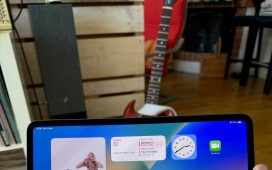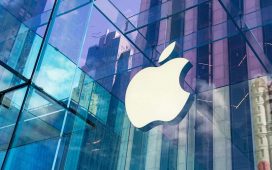Shares of the iPhone maker Apple Inc. were heading south in late trading today after it failed to offer much clarity on the long term impact of President Donald Trump’s tariffs. Growth in its closely-watched services business slowed as well, falling short of Wall Street’s revenue target.
The company reported second-quarter earnings before certain costs such as stock compensation of $1.65 per share, coming in just ahead of the analyst consensus estimate of $1.63 per share. Revenue increased 5% from a year earlier to $95.4 billion, comfortably beating the Street’s target of $94.66 billion.
The strong numbers helped Apple to deliver a net profit of $24.78 billion in the quarter, rising from $23.64 billion in the same quarter one year earlier.
Apple’s most important product line, the iPhone, generated $46.8 billion in sales, up 2% from a year ago and surpassing the Street’s estimates.
However, investors were disappointed to see the slowing growth in Apple’s profitable Services business unit, which covers things like iCloud subscriptions, the App Store, Apple Music, Apple TV+, warranties and revenue from search licensing deals.
While Apple Chief Executive Tim Cook (pictured) hailed the “double-digit growth” in the Services business, it was less impressive than it was three months earlier. Apple said Services sales hit $26.65 billion in the quarter, up 11.6% from a year ago. But in the previous quarter, the division grew its revenue by more than 14%, and the difference is unlikely to have gone unnoticed.
Sales of Apple’s Mac computers and iPad tablets were more encouraging. Mac sales increased 7% from a year ago to just under $8 billion, while iPad revenue surged more than 15% to $6.4 billion. Both business segments were helped by the launch of new, mid-priced products in March, including new MacBook Air laptops and iPad Air devices.
On the other hand, the growth in those segments was offset somewhat by a decline in revenue in the wearables division, which includes devices such as the Apple Watch, AirPods and other accessories. It generated $7.52 billion in sales, down 5% from a year earlier. According to Cook, the decline was partly due to the fact that wearables received a significant boost one year earlier with the launch of Apple’s Vision Pro virtual reality headset.
Apple also failed to make any significant progress in China, its second-largest market in terms of revenue, where it has been losing market share to domestic rivals in the last few years. Sales in the Greater China region, which also includes Hong Kong and Taiwan, dropped about a percentage point to around $16 billion. However, Cook insisted that sales there had increased on a sequential basis, and revenue would have been flat if not for the effects of foreign exchange rates.
The company did much better in the Americas, which is its biggest market segment, with sales rising almost 8% from a year ago. While some analysts claims this is likely due to increased consumer demand ahead of Trump’s tariffs, Cook told analysts on a conference call that the company hasn’t seen any evidence of purchases being pushed forwards due to the tariffs.
“We don’t believe there was a significant pull forward,” he insisted. “There’s no obvious evidence of it.”
During the call, Cook offered analysts and investors his first thoughts on the potential impact of the tariffs on the company’s earnings. He said there was “limited impact” in the second quarter, partly due to Apple planning ahead and optimizing its supply chains.
Apple doesn’t provide official guidance, but the company’s chief financial officer Kevan Parekh said on the call that he’s aiming for “low to mid-single digits” revenue growth in the current quarter. He’s also looking for a gross margin of around 46% after taking into account the cost of tariffs.
Elaborating, Cook told analysts that the company expects tariffs to add around $900 million to its total costs in the current quarter, assuming no changes are announced.
The CEO said that the company has planned as best as it can for the tariffs, explaining that around half of the iPhones destined for the U.S. market are now being sourced from its factories in India. As for the rest of its products, such as Mac computers, iPads and wearables, they’re mostly being manufactured in Vietnam, which, like India, is subject to a much lower tariff than China.
“The majority of iPhones sold in the U.S. will have India as their country of origin,” Cook said. “Vietnam will be the country of origin for almost all iPad, Mac, Apple Watch and AirPods products sold in the U.S.”
The vast majority of Apple products destined for non-U.S. markets are still being made in China, Cook added. He also pointed out that many of the chips used in current-generation iPhones are made domestically. The company will buy 19 billion U.S.-made semiconductors this year, he added.
“With an iPhone, you really have to go a step lower and look at the individual parts and where they come from,” Cook told analysts.
However, Cook refused to discuss the impact of tariffs beyond the current quarter. “I don’t want to predict the future because I’m not sure what will happen with tariffs,” he said. “It’s very difficult to predict beyond June.”
Although Apple rarely offers much by way of guidance beyond its current quarter, investors may have been hoping for a bit more clarity regarding the company’s long-term prospects, given the gravity of the tariff situation. In the wake of its failure to do so, Apple’s stock fell more than 4% in the extended trading session. In the year to date, Apple’s shares are down more than 14%.
Elsewhere, Apple said its board of directors authorized up to $100 billion in share repurchases during the last quarter. Additionally, the company promised to pay a dividend to shareholders of 26 cents per share, up 4% from before.
Photo: Mike Deerkoski/Flickr
Your vote of support is important to us and it helps us keep the content FREE.
One click below supports our mission to provide free, deep, and relevant content.
Join our community on YouTube
Join the community that includes more than 15,000 #CubeAlumni experts, including Amazon.com CEO Andy Jassy, Dell Technologies founder and CEO Michael Dell, Intel CEO Pat Gelsinger, and many more luminaries and experts.
THANK YOU








